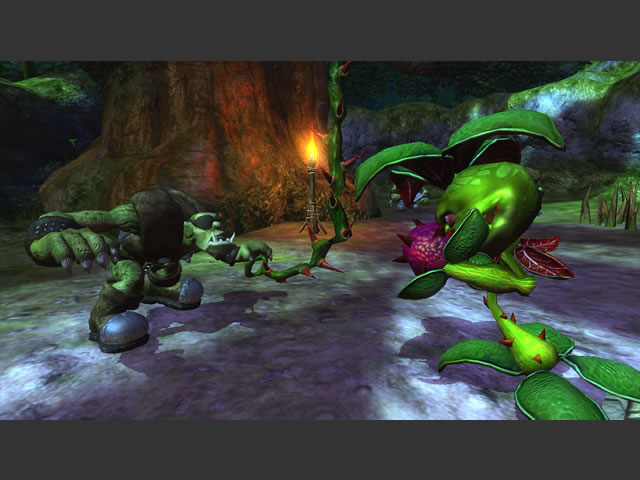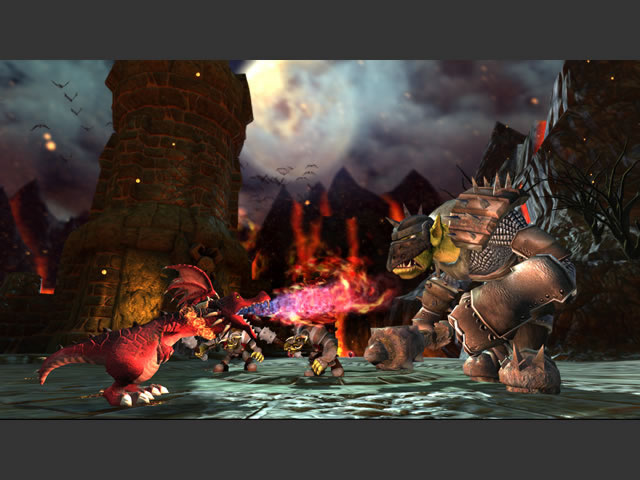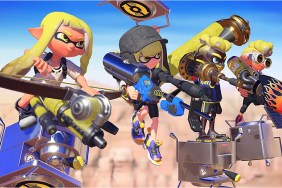Charmed, I’m sure.
In my Tony Hawk’s American Wasteland review, I claimed that every console launch required a platform title starring an endearing lead character. Little did I know that our own Ben Silverman was going to toss that right back in my face not a day later by dropping Kameo: Elements of Power into my quivering hands. Sneaky bastard.
Of course I accepted the challenge. After all, Kameo was developed by Rare, the one-time king of platforming adventures (Banjo-Kazooie, anyone?) and a pretty dependable crew. Luckily, they deftly handle the next-gen of the platformer by bringing a nice balance of brains, speed, and brawn to the table. While it may have a footprint as small as its svelte elfish heroine, it still packs a decent enough punch for a launch title.
The game stars Kameo, daughter of the king of the Enchanted Kingdom, which is under siege by the evil troll army led by Thorn, the Troll King. To make matters worse, Kameo’s jealous sister, Kalus (callous, get it?) has betrayed her kind and joined up with the trolls. You’re dropped into controlling Kameo while she assaults Thorn’s castle to free her captured family, only to be nearly killed and robbed of your powers in very Metroid Prime fashion. Soon you awaken in the Enchanted Kingdom and proceed to go about the task of gathering up ancient elemental warriors to beat Thorn, save your family and bring peace to the land. As if you didn’t see that coming.
The crux of the game lies in rescuing and using elemental forms. Thanks to the guidance of the chatty Wotnot Book (a magical receptacle for your elemental buddies) you’ll quickly find out that most of your ten warrior forms have been captured by ‘shadow trolls’, whom you’ll have to defeat as Kameo to free. These battles all take place in the same shadow realm, a slick looking arena full of swirling clouds and bats. The shadow trolls take and deal out much more punishment as you progress, giving essentially the same battles a needed difficulty boost.
Controlling Kameo and her pets is solid and responsive, even if the camera needs to be directed as much as she does. Switching between the warrior forms is well done, with instant transformation at the press of a face button. While you may only switch between three warriors at a time, a quick flick of the L-stick keeps the rest close at hand without tearing you away from the action. Keeping track of everyone’s moves is a cinch, since they’re constantly displayed at the corners of the screen.
The warrior forms are varied and interesting, and they all play a part in the game’s many small puzzles. Major Ruin, an armadillo, can roll up and launch off ramps, while the abominable snowman Chilla is the only form that can scale walls. You’ll need to use them in conjunction quite often in some fairly innovative if overly easy puzzles. For instance, you use Major Ruin to launch off a ramp, dislodge a bomb, then switch to Ash the dragon to light the fuse. Or you might have to put out a fiery enemy with Deep Blue’s water cannons, then beat them to a pulp with Pummel Weed’s leafy fists.
 Each warrior has their own take on combat, with Chilla using trolls as clubs and projectiles, Ash burning down everything in sight, or Rubble lobbing spiked boulders all over the place. A nice crop of baddies add to the mayhem, requiring more quick changes and new techniques. You’ll even play a sick rendition of pool by using Major Ruin to send armored foes careening off a ramp into the waiting lava.
Each warrior has their own take on combat, with Chilla using trolls as clubs and projectiles, Ash burning down everything in sight, or Rubble lobbing spiked boulders all over the place. A nice crop of baddies add to the mayhem, requiring more quick changes and new techniques. You’ll even play a sick rendition of pool by using Major Ruin to send armored foes careening off a ramp into the waiting lava.
A decent amount of depth is found in purchasing new attacks and other upgrades for the warriors via elemental fruit, found by completing side-quests or simply exploring every last nook and cranny. There’s also a money system in place with shops selling things like new skins, health power-ups, and directions to find more fruit. It’s nothing groundbreaking, but adds to the non-combative side of the game.
Unfortunately, there just isn’t enough. Other than the overworld badlands and a few towns, there are only about six levels in the game, and none of them will put much of a strain on your gray matter. The only replay value lies in Score Attack mode, which lets you play a completed level over again to…score more points. Rewards for the big scorers include new looks, a few movies and some cheats, but the score requirements for them are through the roof. For all Kameo does right in its gameplay, it does wrong in its brevity.
At least Rare saw fit to include some multiplayer. Co-op mode is a simply a split-screen version of Score Attack and offers some minor fun, but it’s still playing through the same old levels, now made even easier. The only online component is leaderboards – no worldwide warrior duels here. It would have been nice to see at least a few more levels, a head-to-head mode, or perhaps a higher difficulty level.
 This child of Rare and Microsoft has no doubt been bred to show off the power of the new console, and it does not disappoint. It’s an almost constant visual assault, from hundreds of trolls and elves constantly warring in the badlands to the gorgeous waterfalls and breeze-blown grass of the Enchanted Kingdom. The character models and environments are all extremely detailed, with enough shimmery particles and lighting effects to illuminate the dark side of the moon. Some neat visual filters come into play in underwater sequences or during the oiled-up, fractal-tastic ‘warrior focus,’ the umpteenth iteration of bullet-time which seems to be a requirement for nearly all games nowadays.
This child of Rare and Microsoft has no doubt been bred to show off the power of the new console, and it does not disappoint. It’s an almost constant visual assault, from hundreds of trolls and elves constantly warring in the badlands to the gorgeous waterfalls and breeze-blown grass of the Enchanted Kingdom. The character models and environments are all extremely detailed, with enough shimmery particles and lighting effects to illuminate the dark side of the moon. Some neat visual filters come into play in underwater sequences or during the oiled-up, fractal-tastic ‘warrior focus,’ the umpteenth iteration of bullet-time which seems to be a requirement for nearly all games nowadays.
Something that is definitely not a standard requirement is really good, original music. After an hour or two, I realized why a soundtrack CD was included in our review kit. Sometimes kooky, sometimes serious orchestration composed by Steve Burke and performed by the Prague Philharmonic beautifully matches the detailed environments, setting an appropriate mood without being overbearing. The sound effects are equally well done, right down to the different footsteps of your warrior forms. Alas, the voice acting is so-so, the enjoyable part being the funny accents applied to various creatures. A little snow-bug talking like a bad Rastafarian has to make you smile.
Which this game is bound to make you do. Kameo isn’t the deepest or most challenging game in the Xbox 360 launch window, but it looks awesome and offers solid, if fleeting, fun. Rather than save the land, this is more a portent of good things to come.











